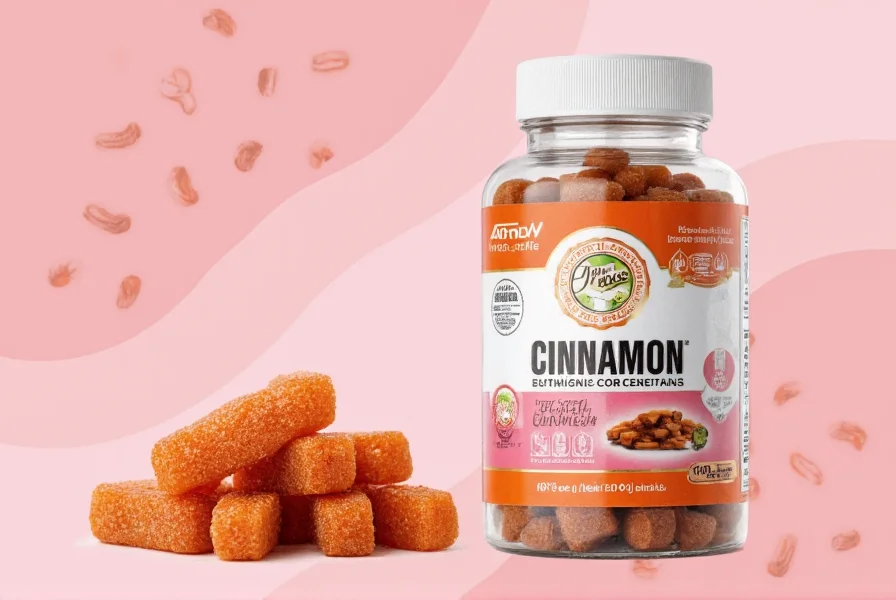Cinnamon gummies represent a popular alternative to traditional cinnamon supplements, offering convenience and palatability for consumers seeking potential health benefits. These chewable supplements typically contain cinnamon extract standardized for active compounds like cinnamaldehyde and polyphenols, formulated with natural sweeteners and flavorings to mask cinnamon's intense taste. Understanding their composition, potential benefits, and limitations is essential for informed usage.
Understanding Cinnamon Varieties in Supplements
Not all cinnamon is created equal in supplement form. The two primary varieties used in cinnamon gummies are:
| Cinnamon Type | Coumarin Content | Common Use in Gummies | Key Considerations |
|---|---|---|---|
| Ceylon ("True" Cinnamon) | Very low (0.004-0.11%) | Preferred for quality supplements | Lower toxicity risk, more expensive |
| Cassia Cinnamon | High (2.15-6.97%) | Common in budget products | Potential liver concerns with prolonged high-dose use |
Reputable cinnamon gummies for blood sugar support typically use Ceylon cinnamon or specify coumarin levels below 0.1mg per serving. Consumers should check product labels for "Cinnamomum verum" (Ceylon) rather than unspecified "cinnamon bark extract," which often indicates Cassia.

Scientific Evidence Behind Cinnamon Gummies Benefits
Current research on cinnamon extract gummies benefits focuses primarily on metabolic health. A 2020 meta-analysis in Nutrition Journal reviewed 16 studies and found cinnamon supplementation associated with modest reductions in fasting blood glucose (average 14.6 mg/dL) and HbA1c levels. However, most studies used capsules rather than gummies, creating a research gap specific to the gummy format.
The effectiveness of cinnamon gummies for blood sugar management depends on several factors:
- Standardized extract concentration (look for products specifying cinnamaldehyde content)
- Daily dosage (studies showing benefits typically used 1-3g of cinnamon equivalent)
- Consistency of use (effects may take 8-12 weeks to manifest)
- Individual metabolic factors
It's important to note that while some clinical trials show promise, the FDA hasn't approved cinnamon supplements for treating or preventing any medical condition. The European Food Safety Authority concluded that evidence for cinnamon's blood sugar effects remains "inconclusive" for establishing cause-effect relationships.
Cinnamon Gummies vs. Other Supplement Forms
When comparing cinnamon supplement gummies vs capsules, several practical considerations emerge:
- Absorption: Gummies may offer slightly faster absorption due to buccal (cheek) absorption pathways, though research comparing bioavailability is limited
- Dosage precision: Capsules typically provide more consistent active compound delivery per serving
- Palatability: Gummies significantly improve compliance for those averse to swallowing pills or bitter tastes
- Additives: Gummies often contain sugars or sugar alcohols that may affect sensitive individuals
For those specifically seeking cinnamon gummies for blood sugar support, products with added compounds like chromium or alpha-lipoic acid may provide synergistic effects, though evidence for these combinations remains preliminary.
Safety Profile and Potential Side Effects
Cinnamon gummies side effects are generally mild but warrant attention. The most significant concern involves coumarin content in Cassia-based products, which in high doses may cause liver toxicity. The European Medicines Agency recommends limiting coumarin intake to 0.1mg per kg of body weight daily.
Other potential considerations include:
- Oral irritation from cinnamon's natural compounds
- Interactions with blood thinners (cinnamon may enhance anticoagulant effects)
- Blood sugar medication interactions (may amplify effects)
- Dental concerns from frequent gummy consumption
Individuals with diabetes, liver conditions, or those taking medications should consult healthcare providers before using cinnamon extract gummies benefits as part of their regimen. Pregnant and breastfeeding women should exercise particular caution due to limited safety data.
Selecting Quality Cinnamon Gummies
When evaluating the best cinnamon gummies for health purposes, consider these evidence-based selection criteria:
- Transparency: Look for products specifying cinnamon species (Ceylon preferred) and coumarin levels
- Standardization: Reputable brands indicate active compound concentrations (e.g., "standardized to 5% cinnamaldehyde")
- Third-party testing: Certifications from NSF, USP, or ConsumerLab verify label accuracy
- Additive profile: Minimal added sugars (under 2g per serving) and natural flavorings
- Dosage: Sufficient daily cinnamon equivalent (studies used 1-3g, equivalent to 500-1500mg extract)

Avoid products making exaggerated claims like "cures diabetes" or "guaranteed weight loss," as these violate supplement labeling regulations and indicate poor quality control. The most reliable cinnamon gummies for blood sugar support will present realistic expectations based on current research limitations.
Practical Usage Guidelines
For those incorporating cinnamon gummies into their wellness routine, evidence-based usage recommendations include:
- Take with meals to potentially enhance blood sugar management effects
- Maintain consistent daily use (effects may require 8-12 weeks to manifest)
- Monitor blood markers if using for metabolic health purposes
- Store in cool, dry conditions to preserve active compounds
- Consider rotating supplement forms periodically to assess comparative effectiveness
Remember that cinnamon supplements work best as part of a comprehensive approach including balanced nutrition, regular exercise, and appropriate medical care. They should never replace prescribed treatments for medical conditions.
Research Limitations and Future Directions
While preliminary research on cinnamon gummies benefits is promising, significant limitations exist. Most clinical trials have used cinnamon capsules or powders rather than gummies, creating uncertainty about format-specific efficacy. Additionally, study durations typically range from 4-16 weeks, leaving long-term effects poorly understood.
Future research should address:
- Direct comparisons between gummy and capsule formats
- Long-term safety profiles (beyond 6 months)
- Optimal dosing strategies for specific health goals
- Interactions with common medications
- Effects on diverse population groups
Until more robust evidence emerges, consumers should maintain realistic expectations about what cinnamon extract gummies benefits can reasonably deliver.
Do cinnamon gummies really help with blood sugar control?
Some clinical studies show modest improvements in blood sugar markers with cinnamon supplementation, but most research used capsules rather than gummies. Effects appear modest (typically 10-15% improvement in fasting glucose) and may take 8-12 weeks to manifest. Cinnamon gummies for blood sugar should complement, not replace, standard diabetes management approaches.
How much cinnamon should be in quality gummies?
Effective cinnamon gummies typically provide 250-500mg of standardized cinnamon extract per serving, equivalent to 1-2g of whole cinnamon. Look for products specifying cinnamaldehyde content (ideally 2-5%) and preferably using Ceylon cinnamon with coumarin levels below 0.1mg per serving.
Are there any medication interactions with cinnamon gummies?
Yes, cinnamon may interact with blood thinners (like warfarin) due to coumarin content, and potentially enhance effects of diabetes medications. Those taking liver-metabolized drugs should consult healthcare providers before using cinnamon gummies, especially Cassia-based products with higher coumarin levels.
How long does it take to see results from cinnamon gummies?
Research suggests it may take 8-12 weeks of consistent daily use to observe potential benefits for metabolic health markers. Individual responses vary based on dosage, cinnamon type, baseline health status, and overall lifestyle factors. Tracking relevant biomarkers with healthcare provider guidance provides the most reliable assessment.
What's the difference between Ceylon and Cassia cinnamon in gummies?
Ceylon cinnamon (Cinnamomum verum) contains minimal coumarin (0.004-0.11%) making it safer for regular use, while Cassia cinnamon has significantly higher coumarin levels (2.15-6.97%) that may pose liver risks with prolonged use. Quality cinnamon gummies for health purposes should specify Ceylon cinnamon or provide coumarin content testing results.











 浙公网安备
33010002000092号
浙公网安备
33010002000092号 浙B2-20120091-4
浙B2-20120091-4